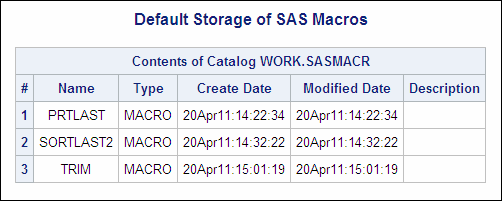Storing Macro Definitions in Catalog SOURCE Entries
Overview
Another way of permanently storing macros is to store
a macro definition in a SOURCE entry in a SAS catalog. If you decide
to store your macro programs in a SAS catalog, you must store each
macro program in a separate SOURCE entry. It is a good idea to give
each SOURCE entry the same name as the macro program that is stored
within it. For example, a macro named
Printit would
be stored in a SOURCE entry that is also named Printit.
Note: SAS catalogs are members
of SAS libraries that store program source code and other types of
content.
To store a macro definition
as a SOURCE entry in a SAS catalog, you use the Save As Object window.
Example
To save the
Printit macro
definition to the Sasuser.Mymacs catalog, perform these steps:
Tip
If you use the Program Editor,
you could also use the SAVE command to save your macro definition
as a catalog SOURCE entry. To use the SAVE command, you enter save libref.catalog.entry.source in
the command line where libref.catalog.entry is
the libref, the catalog name, and the entry name.
The CATALOG Procedure
If you store your
macros in a SAS catalog, you might want to view the contents of a
particular catalog to see the macros that you have stored there. You
can use the Explorer window to view the contents
of a SAS catalog by navigating to the catalog and double clicking
it. You can also use the CATALOG procedure to list the contents of
a SAS catalog. The CONTENTS statement of the CATALOG procedure lists
the contents of a catalog in the procedure output.
|
General form, CATALOG
procedure with CONTENTS statement:
PROC CATALOG CATALOG=libref.catalog;
CONTENTS;
QUIT;
libref.catalog
is a valid two-level
catalog name.
|
Note: CAT= is an alias for CATALOG.
Example
You can use PROC CATALOG
to view all of the macros that are stored in the temporary Work.Sasmacr
catalog, as follows:
proc catalog cat=work.sasmacr; contents; title "Default Storage of SAS Macros"; quit;
This PROC CATALOG step
produces results that are similar to the output shown below. The macros
that are actually listed are the macros that have been compiled during
the current SAS session.
PROC CATALOG can display
the names and attributes of compiled macros, but the macro definition
itself cannot be viewed.
The CATALOG Access Method
If you store a
macro definition in a SOURCE entry of a SAS catalog, you can use the
CATALOG access method in a FILENAME statement in conjunction with
the %INCLUDE statement to insert the macro definition into a SAS program.
|
General form, CATALOG
access method to reference a single SOURCE entry:
FILENAME fileref
CATALOG 'libref.catalog.entry-name.entry-type';
%INCLUDE fileref;
fileref
is a valid fileref.
libref.catalog.entry-name.entry-type
is a four-level SAS
catalog entry name.
entry-type
is SOURCE.
|
Example
Suppose you have stored
the following macro definition as a SOURCE entry in the SAS catalog
Sasuser.Mymacs:
%macro prtlast;
%if &syslast ne _NULL_ %then %do;
proc print data=&syslast(obs=5);
title "Listing of &syslast data set";
run;
%end
%else
%put No data set has been created yet.;
%mend;You can use the CATALOG
access method along with the %INCLUDE statement to compile the macro
Prtlast.
Then you can reference the macro later in the program. filename prtlast catalog 'sasuser.mymacs.prtlast.source'; %include prtlast; proc sort data=sasuser.courses out=bydays; by days; run; %prtlast
You can also use the
CATALOG access method to reference multiple SOURCE entries as long
as the entries are stored in the same SAS catalog.
|
General form, CATALOG
access method to reference multiple SOURCE entries:
FILENAME fileref CATALOG 'libref.catalog';
%INCLUDE fileref(entry-1);
%INCLUDE fileref(entry-2);
fileref
is a valid fileref.
libref.catalog
is a two-level catalog
name.
entry-1 and entry-2
are names of SOURCE
entries in library.catalog.
|
Example
Suppose you have two
macros, named
Prtlast and Sortlast,
that are stored in a SAS catalog.
Catalog Entry: Sasuser.Mymacs.Prtlast.Source
%macro prtlast;
%if &syslast ne _NULL_ %then %do;
proc print data=&syslast(obs=5);
title "Listing of &syslast data set";
run;
%end;
%else
%put No data set has been created yet.;
%mend;Catalog Entry: Sasuser.Mymacs.Sortlast.Source
%macro sortlast(sortby);
%if &syslast ne _NULL_ %then %do;
proc sort data=&syslast out=sorted;
by &sortby;
run;
%end;
%else
%put No data set has been created yet.;
%mend;You can use the CATALOG
access method in conjunction with the %INCLUDE statement to compile
both macros. Then you can call the macros later in the program. In
this example, assume that the macros have the same names as the SOURCE
entries in which they are stored:
filename prtsort catalog 'sasuser.mymacs'; %include prtsort(prtlast) / source2; %include prtsort(sortlast) / source2; data current(keep=student_name course_title begin_date location); set sasuser.all; if year(begin_date)=2001; diff=year(today())-year(begin_date); begin_date=begin_date+(365*diff); run; %sortlast(begin_date) %prtlast
This code produces the
following output:
..................Content has been hidden....................
You can't read the all page of ebook, please click here login for view all page.


